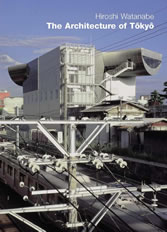Suchen und Finden
Service
The Architecture of Tokyo
Hiroshi Watanabe
Verlag Edition Axel Menges, 2001
ISBN 9783930698936 , 264 Seiten
Format PDF, OL
Kopierschutz DRM
Geräte
The Tokyo region is the most populous metropolitan area in the world and a place of extraordinary vitality. The political, economic and cultural centre of Japan, Tokyo also exerts an enormous international influence. In fact the region has been pivotal to the nation’s affairs for centuries. Its sheer size, its concentration of resources and institutions and its long history have produced buildings of many different types from many different eras.
This is the first guide to introduce in one volume the architecture of the Tokyo region, encompassing Tokyo proper and adjacent prefectures, in all its remarkable variety. The buildings are presented chronologically and grouped into six periods: the medieval period (1185–1600), the Edo period (1600–1868), the Meiji period (1868–1912), the Taisho and early Showa period (1912–1945), the postwar reconstruction period (1945–1970) and the contemporary period (1970 until today). This comprehensive coverage permits those interested in Japanese architecture or culture to focus on a particular era or to examine buildings within a larger temporal framework. A concise discussion of the history of the region and the architecture of Japan develops a context within which the individual works may be viewed.
Nearly 600 buildings are presented, from 15th-century Buddhist temples to 20th-century cultural buildings, from venerable folkhouses to works by leading contemporary architects of Japan such as Kenzo Tange, Fumihiko Maki, Arata Isozaki, Hiroshi Hara, Toyo Ito and Riken Yamamoto as well as by foreign architects such as Norman Foster, Peter Eisenman and Steven Holl.
Hiroshi Watanabe studied architecture at Princeton University in Princeton, N. J., and at Yale University in New Haven, Conn. He has written extensively on contemporary Japanese architecture and on the work of architects from Western countries in Japan. He was the Japan correspondent for Progressive Architecture for many years. His writings include Amazing Architecture from Japan and the text for the monograph on the Marugame Hirai Museum by Alfredo Arribas (published by Edition Axel Menges). He also translated Space in Japanese Architecture by Mitsuo Inoue.
Service
Shop



